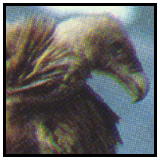HimalayanOrder: Falconiformes. Himalayan Griffon (Copyright ©2000)Family: Accipitridae. (Old World vulture). Scientific Name: Gyps himalayensis. Common Names: Himalayan Griffon. Conservation
Status: Rare.
It is recognised that these birds may be reducing in numbers, but
they are extremely difficult to monitor. These birds are periodic
visitors to wildlife parks and it is noticeable numbers have severely
lessened; in some areas no birds have been sighted in parks since
1996, though plenty of food is still available which should continue
to attract them. As a result there is a query over whether or not
the same illness that is affecting the Asian White-backed and the
Long-billed Griffons could also be decimating the Himalayan Griffon;
a census of bird populations has been recommended. Himalayan Griffon (Copyright ©2000)Rescue & Recovery: None. Geographical Range: Himalayas. Habitat: A bird of very high mountain ranges. Often found at heights of up to 7,440 metres above sea level. Physical Characteristics: For some unknown reason the Himalayan Griffon has fourteen tail feathers, whereas the norm for birds is only twelve. The back and wings are a dark chocolate brown while the stomach feathers are light brown and white. It is a huge vulture reaching 1.25 metres in length and with a head and neck which are not bare but are covered in a long fluffy layer of down, which becomes a long ruff at the base of the neck. This is a very aggressive birds which dominates at a carcass. Food: Carrion. This includes the remains of goats, yaks and even humans. Reproduction: Unknown.
Himalayan Griffon (Copyright ©2000)
|



